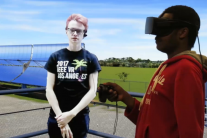The University of Louisiana at Lafayette has taken its place in the top level of the nation’s research institutions
New VR technology joins Lafayette with Australian city
Fri, 01/19/2018 - 9:24amSet more than 9,400 miles apart, the cities of Lafayette, La. and Adelaide, Australia are now connected — virtually.
U.S. Ignite Inc., a nonprofit organization that works to advance technology and build foundations for smart cities, and Ignite SA, the first smart gigabit community outside of North America, recently announced a successful virtual reality demonstration linking the two cities using new VR technology.
“Connecting a virtual reality application in Louisiana to Australia was not easy,” said William Wallace, executive director of U.S. Ignite, “but it is a testament to the idea that anything is possible on an advanced gigabit network.”
Dr. Christoph Borst, a computer science professor at the University of Louisiana at Lafayette, and computer science doctoral student Nicholas Lipari created the new application called “Kvasir-VR” to deploy into classrooms and provide K-12 students with unlimited “field trip” opportunities.
What sets Kvasir-VR apart from other VR technologies is its injection of livestreamed 3-D imagery into a VR setting, immersing the user in more than one way.
“It’s not a normal avatar that you’d usually see,” Borst explained. “It looks like you’re actually seeing the person standing in front you. That’s what I’m interested in. How do you improve the VR experience?”
The pair initially brought the technology to David Thibodaux STEM Magnet Academy in Lafayette to study how students responded to the digital learning platform. During the experiment, the students were given a virtual tour of UL Lafayette’s Cleco Alternative Energy Center in Crowley, which also included a livestream of their teacher.
Now, the newly formed relationship with Adelaide could mean bringing the technology into international classrooms.
“As the first international city to join U.S. Ignite’s network of Smart Gigabit Communities, we are especially thrilled to have the opportunity to work with Lafayette,” said Jasmine Vreugdenburg, community leader of Ignite SA. “We are so grateful to U.S. Ignite for facilitating this connection, and we are excited to see what the future holds for our partnership with Lafayette.”
Kvasir-VR originally began as a networked VR system for remotely-guided geosciences explorations, connecting geology professor Dr. Gary Kinsland in Borst’s lab located on campus to a live audience in the Louisiana Immersive Technology Enterprise’s 3-D theater.
With an initial National Science Foundation grant of $329,763 and a $10,000 Mozilla grant, Borst and Lipari were able to apply the concept to the solar energy center, with help from Dr. Terrence Chambers, a mechanical engineering professor and the center’s director.
The demo was presented to more than a thousand people at the 2016 Smart Cities Innovation Summit in Austin, Texas, winning U.S. Ignite’s “Most Unconventional Use of Gigabit” award and an additional $10,000 grant.
Currently, Borst is studying the educational effects of having a livestreamed teacher in the virtual environment.
“This virtual reality application developed by Dr. Borst’s team has the potential to benefit children around the world,” Wallace stated. “We look forward to seeing future innovations resulting from this collaboration.”
(Photo credit: Center for Advanced Computer Studies Virtual Reality Lab)

